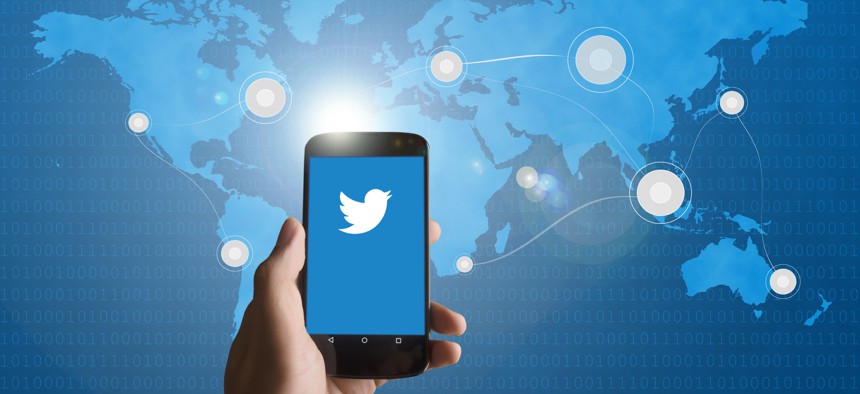
edar via CC0
What We Didn't Learn from Twitter's News Dump on Russiagate
The social-media company downplayed its role in Russia's election meddling. But it's still more transparent than Facebook.
For a technology that is instant and global, the social media industry has certainly learned the value of the Washington DC tradition of “Friday News Dump.” Last night, amid a pending U.S. government shutdown and a presidential porn payoff scandal, Twitter released its long-awaited report on Russian uses of its platform to interfere in the 2016 presidential election.
In many ways, the numbers were striking. Looking back, Twitter officials said, they had found a cluster of 3,814 accounts that were “a propaganda effort by a Russian government-linked organization known as the Internet Research Agency (IRA).” These were supplemented by a broader project of 50,258 automated accounts — bots — which spread the messaging further. In total, 677,775 people in the United States followed one of these accounts or retweeted or liked a Tweet from these accounts during the election period. Twitter also gave examples of the messaging, which ranged from efforts to support Donald Trump’s election to not-so-ironic attempts to undermine the credibility of former FBI Director Comey and those investigating the very same Russian influence operations.
Twitter, however, played the impact down. Its report said, for example, that the accounts represented “two one-hundredths of a percent (0.016%) of the total accounts on Twitter at the time.” One can expect that this will become a talking point both for the firm and those who want to underplay the Russian operations.
Social media, though, is about scale and networking, and this combination means that, in actuality, the numbers are far worse than they seem. To begin, the algorithms that underscore social media can be gamed, as everyone from teens to ISIS to Russian trolls have figured out. As long as they are working in synchronization, a relatively small number of accounts can help steer trends and launch hashtags that then other eyes are drawn to, not so ironically by more automated accounts.
Even more importantly, the numbers Twitter provided only show a limited story of the actual reach of this Russian effort to divide and reshape American politics.
To begin, it only covers the IRA related numbers, which was only one node in the Russian effort. Nor does it reveal how many actually viewed the efforts of this subset or their impact by percentage of tweets or views on a per-topic basis, which would flesh out the actual impact — not just on the election, but on issues within it.
As an illustration, the Twitter account of Trump surrogate-turned-National Security Advisor-turned-confessed liar Gen. Michael Flynn, followed at least five of these documented Russian influence ops accounts, pushing out their messaging to all his almost two hundred-thousand followers at least 25 times. Similarly, @Ten_GOP, which called itself the “Unofficial Twitter account of Tennessee Republicans,” but was actually a Russian account, was followed by over 100,000 people. Its messages echoed out to potentially millions via retweets from influential figures like Donald Trump Jr. and Kellyanne Conway, who each have over two million followers. Indeed, on Election Day 2016, it was the seventh-most-retweeted account of the entire network
Nor does the data show the echo effect of such accounts beyond the network. Another such account was @Jenn_Abrams , which posed as an American girl with strong views on everything from Kim Kardashian’s clothes to immigration and the need to support Donald Trump. “She” not only built up 70,000 followers, but, due to the now-lamentable media practice of embedding tweets in articles without confirmation of the source, was also quoted in The New York Times, U.S. News and World Report, USA Today, Fox, BET, Yahoo Sports, Sky News, IJR, Breitbart, The Washington Post, Mashable, New York Daily News, Quartz, Dallas News, France24, HuffPost, The Daily Caller, The Telegraph, CNN, the BBC, Gizmodo, The Independent, The Daily Dot, The Observer, Business Insider, The National Post, Refinery29, The Times of India, BuzzFeed, The Daily Mail, and (unsurprisingly) InfoWars, Russia Today and Sputnik. But “she” still only counts as a 1 in the Twitter count.
Another key gap in the data is the timing. It only looks at the period of 10 weeks before the November 8, 2016, election. That is, it misses the entire nomination process that dragged out for well over a year. None of the data thus includes the period that social media arguably mattered most, when it was a key force to both the rise of Donald Trump (who went from outsider to an unstoppable force online) amid a crowd of 19 Republican candidates and in shaping the enduring narratives that Hillary Clinton would prove unable to shake. It also, of course, doesn't cover the efforts by Russia that have continued since. From the election to today, Russia has maintained an effort to reshape and distort American political discourse on everything from the Charlottesville killing to this week’s #releasethememo tempest in a teapot.
Finally, there is a problem in even how this only partial story is communicated, not just to the public, but the targets themselves. If you are one of those to be contacted by Twitter, their message doesn’t tell the user any specifics about either the content or the account that they were fooled by. So there is no way for the person to know how the Russian campaign worked against them personally, on what topic, nor how to avoid being taken in again. It is akin to your car company reaching out to say that “Something on your car is wrong and we kinda did something about it.”
It is not all bad news. Twitter at least is to be applauded for meeting the bare minimum of at least attempting to contact the people who followed such accounts (notably via email), to let them know they have been played by Russian government propagandists. This stands in contrast to Facebook, which saw arguably even greater and more successful Russian efforts. (As an illustration, “Secure Borders,” an anti-Clinton Facebook group of over 140,000 subscribers, was actually run out of the same St. Petersburg office. By combining online circulation with heavy ad buys, just one of its posts peaked to hit 4 million people on Facebook and was ‘liked’ more than 300,000 times.) In contrast to Twitter’s pushout, Facebook has decided to put the information on such Russian ops on a desktop-only site that one must seek out. This does not just place the onus on the customer to work to find the news that they were tricked, but is an interesting placement decision for a company that has shifted its entre strategy around mobile use.
Overall, the timing and limited content of the Twitter release, combined with Facebook’s announcement that it would defer the battle against misinformation to a new system of user votes (which will surely be manipulated by the very same attackers, as well as partisan troll armies and TV talk show hosts), shows a core problem. The companies that operate our new media ecosystem are still to come fully to grips with both the role that misuse of their platforms played in shaping our current politics and the responsibilities they bear in ensuring it never happens again.
